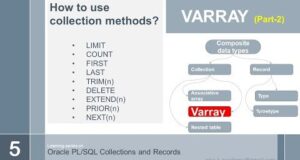REQUEST COMPLIMENTARY SQLS*PLUS LICENCE
Oracle PRIOR and NEXT methods

In Oracle PL/SQL, the PRIOR and NEXT methods are functions that allow you to move back and forth in the collection (ignoring the deleted items even if DELETE stores fillers for them). These methods are useful for crossing rare collections.
Considering the index:
- PRIOR returns the index of the previous existing element in the collection, if any. Otherwise, PRIOR returns NULL.
- For any collection c, c.PRIOR (c.FIRST) returns NULL.
- NEXT returns the index of a subsequent existing collection item, if one exists. Otherwise, NEXT returns NULL.
- For any c collection, c.NEXT (c.LAST) returns NULL.
- This index does not have to exist. However, if the collection is Varray, the index cannot exceed LIMIT.
Syntax of PRIOR and NEXT collection methods in Oracle PL/SQL
collection_name.PRIOR;
collection_name.NEXT;
Parameters and arguments of PRIOR and NEXT collection methods
- collection_name – the name of the collection.
- PRIOR – the previous existing element of the collection.
- NEXT – the next existing element of the collection.
See also collection methods: DELETE, TRIM, EXTEND, EXISTS, FIRST and LAST, COUNT, LIMIT.
An example to understand how to use the PRIOR and NEXT collection methods in Oracle PL/SQL
An example that initializes a Nested Table with six elements, removes the fourth element and then shows the PRIOR and NEXT values for elements 1 to 7. Elements 4 and 7 do not exist. Element 2 exists despite its zero value.
DECLARE
TYPE nt_type IS TABLE OF NUMBER;
nt nt_type := nt_type(18, NULL, 36, 45, 54, 63);
BEGIN
nt.DELETE(4);
DBMS_OUTPUT.PUT_LINE('nt(4) was deleted.');
FOR i IN 1...7 LOOP
DBMS_OUTPUT.PUT('nt.PRIOR(' || i || ') = '); print(nt.PRIOR(i));
DBMS_OUTPUT.PUT('nt.NEXT(' || i || ') = '); print(nt.NEXT(i));
END LOOP;
END LOOP;
Result:
nt(4) was deleted.
nt.PRIOR(1) = NULL
nt.NEXT(1) = 2
nt.PRIOR(2) = 1
nt.NEXT(2) = 3
nt.PRIOR(3) = 2
nt.NEXT(3) = 5
nt.PRIOR(4) = 3
nt.NEXT(4) = 5
nt.PRIOR(5) = 3
nt.NEXT(5) = 6
nt.PRIOR(6) = 5
nt.NEXT(6) = NULL
nt.PRIOR(7) = 6
nt.NEXT(7) = NULL
For an Associative Array indexed by a string, the previous and next indexes are determined by the key values, which are in sorted order. In the example below, FIRST, NEXT and WHILE LOOP loop are used to print Associative Array elements.
DECLARE
TYPE NumList IS TABLE OF NUMBER;
n NumList := NumList(1, 2, NULL, NULL, 5, NULL, 7, 8, 9, NULL);
subscript INTEGER;
BEGIN
DBMS_OUTPUT.PUT_LINE('First to last:');
subscript := n.FIRST;
WHILE subscript IS NOT NULL LOOP
DBMS_OUTPUT.PUT('n(' || subscript || ') = ');
print(n(subscript));
subscript := n.NEXT(subscript);
END LOOP;
DBMS_OUTPUT.PUT_LINE('--------------');
DBMS_OUTPUT.PUT_LINE('Last to first:');
subscript := n.LAST;
WHILE subscript IS NOT NULL LOOP
DBMS_OUTPUT.PUT('n(' || subscript || ') = ');
print(n(subscript));
subscript := n.PRIOR(subscript);
END LOOP;
END;
Result:
First to last:
n(1) = 1
n(2) = 2
n(3) = NULL
n(4) = NULL
n(5) = 5
n(6) = NULL
n(7) = 7
n(8) = 8
n(9) = 9
n(10) = NULL
--------------
Last to first:
n(10) = NULL
n(9) = 9
n(8) = 8
n(7) = 7
n(6) = NULL
n(5) = 5
n(4) = NULL
n(3) = NULL
n(2) = 2
n(1) = 1
This example prints the elements of an unlimited Nested Table from first to last using FIRST and NEXT, and from last to first using LAST and PRIOR.
PL/SQL tutorial: PL/SQL Collection Method Prior & Next in Oracle Database
MORE NEWS
PreambleNoSql is not a replacement for SQL databases but is a valid alternative for many situations where standard SQL is not the best approach for...
PreambleMongoDB Conditional operators specify a condition to which the value of the document field shall correspond.Comparison Query Operators $eq...
5 Database management trends impacting database administrationIn the realm of database management systems, moreover half (52%) of your competitors feel...
The data type is defined as the type of data that any column or variable can store in MS SQL Server. What is the data type? When you create any table or...
PreambleMS SQL Server is a client-server architecture. MS SQL Server process starts with the client application sending a query.SQL Server accepts,...
First the basics: what is the master/slave?One database server (“master”) responds and can do anything. A lot of other database servers store copies of all...
PreambleAtom Hopper (based on Apache Abdera) for those who may not know is an open-source project sponsored by Rackspace. Today we will figure out how to...
PreambleMongoDB recently introduced its new aggregation structure. This structure provides a simpler solution for calculating aggregated values rather...
FlexibilityOne of the most advertised features of MongoDB is its flexibility. Flexibility, however, is a double-edged sword. More flexibility means more...
PreambleSQLShell is a cross-platform command-line tool for SQL, similar to psql for PostgreSQL or MySQL command-line tool for MySQL.Why use it?If you...
PreambleWriting an application on top of the framework on top of the driver on top of the database is a bit like a game on the phone: you say “insert...
PreambleOracle Coherence is a distributed cache that is functionally comparable with Memcached. In addition to the basic function of the API cache, it...
PreambleIBM pureXML, a proprietary XML database built on a relational mechanism (designed for puns) that offers both relational ( SQL / XML ) and...
What is PostgreSQL array? In PostgreSQL we can define a column as an array of valid data types. The data type can be built-in, custom or enumerated....
PreambleIf you are a Linux sysadmin or developer, there comes a time when you need to manage an Oracle database that can work in your environment.In this...
PreambleStarting with Microsoft SQL Server 2008, by default, the group of local administrators is no longer added to SQL Server administrators during the...















